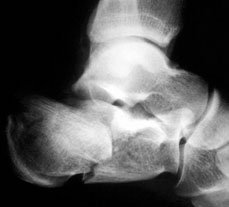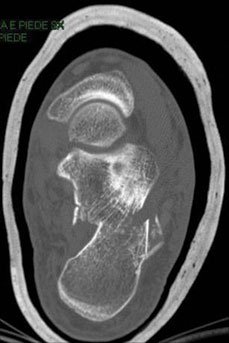Fewer complications with minimal invasive osteosynthesis for displaced calcaneal fractures
Researchers found better outcomes among patients treated with minimally invasive osteosynthesis than open reduction internal fixation.
SAN FRANCISCO — Researchers reported fewer complications and better patient satisfaction with minimally invasive osteosynthesis compared to open reduction internal fixation for displaced articular calcaneal fractures, according to a study presented at the American Academy of Orthopaedic Surgeons 2012 Annual Meeting, here.
“Both techniques are anatomic or nearly anatomic reduction,” Sandro Giannini, MD, and Cesare Faldini, MD, of Istituto Ortopedico Rizzoli in Bologna, said. “Reduction of the posterior articular facets was achieved in the majority of cases. In minimally invasive osteosynthesis (MIO), and in open reduction internal fixation (ORIF), radiographic and functional results are expected to be equal, but the preservation of the soft tissue during MIO led to considerably less complications.”
Comparison of techniques
Giannini and colleagues compared clinical results of MIO with ORIF for fusion of displaced intra-articular calcaneal fractures. They included 103 patients aged 18 years to 57 years with 108 calcaneus fractures; 63 patients underwent MIO and 40 patients underwent ORIF. All patients had undergone lateral and axial view radiographs and CT preoperatively to identify fracture anatomy.

This patient was randomized to undergo open reduction internal fixation (ORIF) for a displaced intra-articular calcaneal fracture.

This radiograph shows the patient’s 1-year postoperative result with ORIF using plates and screws.
Images: Faldini C
For MIO procedures, investigators began with a 3 cm lateral skin incision enlarged distally 1 cm or 2 cm, including the calcaneal joint only if it was involved, according to Giannini and Faldini. They then reduced the fracture and fixed the fragments with one or two screws based on the anatomy of each fracture, applying one or two screws to the tuberosities to fix larger fragments.
In the ORIF cases, surgeons made L-shaped lateral incisions along the shape of the foot, followed by subtalar joint reduction fixed with one or two screws and “application of a plate from the calcaneal tuberosity to the anterior part of the calcaneus,” Giannini and Faldini said.
Better MIO outcomes
All patients were immobilized in boots and not allowed to weight bear. But after 6 weeks to 8 weeks they could partially weight bear with full weight bearing allowed at 10 weeks to 12 weeks. Investigators based the outcomes on the American Orthopaedic Foot and Ankle Society (AOFAS) score, radiographs and CT scans.

A CT scan shows the calcaneus fracture of a patient in the minimally invasive osteosynthesis (MIO) group.

Patients in the MIO group, like this patient whose fracture was treated 2 years earlier, received a few screws placed through a 3-cm lateral skin incision.
Fractures in both groups healed at 4 months postoperatively, mean. Giannini and colleagues found excellent or good AOFAS scores in 53 patients who underwent MIO and 30 patients who underwent ORIF.
At a mean follow-up of 6 years, 2 patients in the MIO group showed delayed skin healing, but there were no infections in that cohort. Five patients treated with ORIF had delayed skin healing, 1 patient had a sural nerve injury, 2 patients had infections, and 28 patients presented with radiographic signs of subtalar joint arthritis, which was painful in 10 cases.
“This was very interesting because in both groups there was a strong correlation between the good reduction and good result,” Giannini and Faldini said. “In fact, near non-anatomic reduction and failure of reduction were always associated with failure and poor results in both groups.” – by Renee Blisard Buddle
Reference:
- Giannini S, Faldini C, Cadossi M, et al. Minimally invasive osteosynthesis versus open reduction and internal fixation in displaced calcaneal fractures. Paper #625. Presented at the American Academy of Orthopaedic Surgeons 2012 Annual Meeting. Feb. 7-11. San Francisco.
For more information
- Sandro Giannini, MD, and Cesare Faldini, MD, can be reached at Via G. Pupilli 1, 40136 Bologna, Italy; email: sandro.giannini@ior.it.
Disclosure:
- Giannini and Faldini have no relevant financial disclosures.
